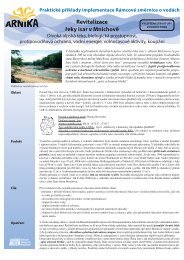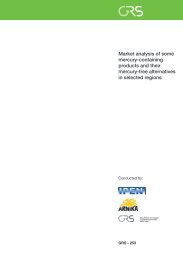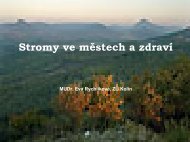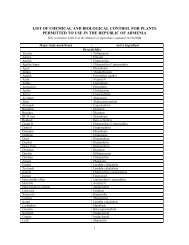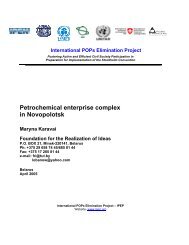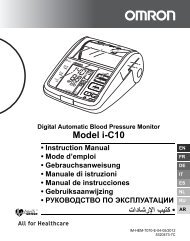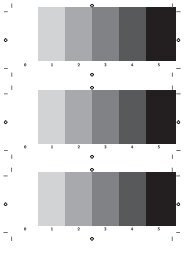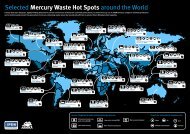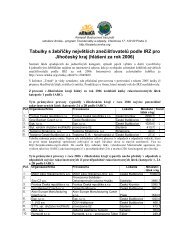Mercury in Fish 1.45 Mb - Arnika
Mercury in Fish 1.45 Mb - Arnika
Mercury in Fish 1.45 Mb - Arnika
Create successful ePaper yourself
Turn your PDF publications into a flip-book with our unique Google optimized e-Paper software.
Page 11 <strong>Mercury</strong> Policy Project<br />
<strong>Mercury</strong> <strong>in</strong> <strong>Fish</strong><br />
weight of the consumer. These factors can<br />
comb<strong>in</strong>e <strong>in</strong> various ways to create excessive<br />
exposure.<br />
For example, someone who eats a food with<br />
or pilot whale meat, can get an excessive<br />
mercury dose by eat<strong>in</strong>g relatively<br />
modest amounts of those foods.<br />
On the other hand, among<br />
populations with a high rate<br />
as the people of West<br />
Bengal, a relatively<br />
low average level<br />
of mercury <strong>in</strong> the<br />
can still result <strong>in</strong><br />
excessive exposure.<br />
And people with<br />
smaller body<br />
and many adults <strong>in</strong><br />
a larger mercury dose<br />
from the same meal<br />
than would a person with<br />
a greater body mass.<br />
In Table 6, below, we have<br />
created scenarios describ<strong>in</strong>g a<br />
variety of exposure situations <strong>in</strong> each country<br />
or region covered by this report, us<strong>in</strong>g data<br />
presented above for methylmercury levels<br />
<strong>in</strong> foods, and some appropriate assumptions<br />
about food <strong>in</strong>take and body weight.<br />
Methylmercury doses to which people would<br />
be exposed <strong>in</strong> each scenario were calculated,<br />
then compared to the three reference levels.<br />
The right-hand columns of the table show the<br />
ratios of each scenario’s consumer exposure<br />
compared to the three reference levels. A<br />
number greater than 1.0 <strong>in</strong> these columns<br />
means the <strong>in</strong>dicated standard is exceeded;<br />
a number of 4.50 <strong>in</strong> the column for the<br />
WHO Prenatal PTWI, for example, means<br />
consumer exposure <strong>in</strong> that scenario exceeds<br />
that reference level by 4.5-fold. Numbers less<br />
than 1.0 <strong>in</strong>dicate that the scenario’s consumer<br />
exposure is with<strong>in</strong> the <strong>in</strong>dicated reference<br />
guidel<strong>in</strong>e.<br />
The table <strong>in</strong>cludes just a few of myriad<br />
possible exposure scenarios, particularly<br />
for the Indian situation, <strong>in</strong> which the<br />
data <strong>in</strong> Appendix C show large<br />
differences <strong>in</strong> the average<br />
dozen different locations <strong>in</strong><br />
West Bengal. Scenarios<br />
were chosen to span<br />
the range of possible<br />
exposures, but are<br />
not all-<strong>in</strong>clusive. The<br />
assumptions used <strong>in</strong><br />
each case are expla<strong>in</strong>ed<br />
<strong>in</strong> our exposure analysis<br />
for each country,<br />
below.<br />
The overall conclusion<br />
of this analysis is that<br />
consumers <strong>in</strong> all geographic<br />
areas covered by this report are<br />
likely to exceed some or all of the<br />
reference levels for methylmercury<br />
exposure under many circumstances.<br />
The US EPA RfD, the strictest of the three<br />
reference levels, is exceeded <strong>in</strong> 100% of<br />
these scenarios. The WHO PTWI for prenatal<br />
exposure is exceeded <strong>in</strong> 26 of the 28 scenarios,<br />
and the WHO PTWI for general exposure,<br />
the least str<strong>in</strong>gent of the three, is also clearly<br />
exceeded <strong>in</strong> 22 of the 28 scenarios exam<strong>in</strong>ed<br />
here.



